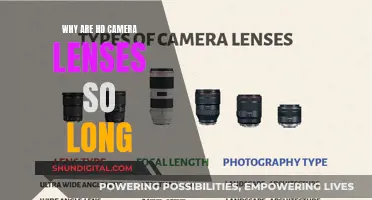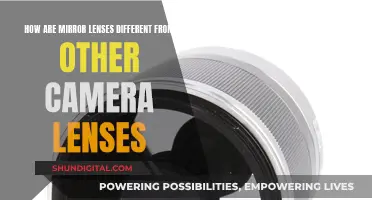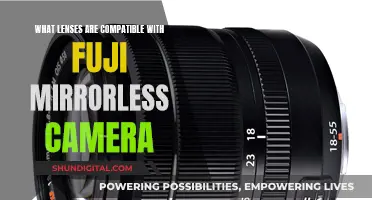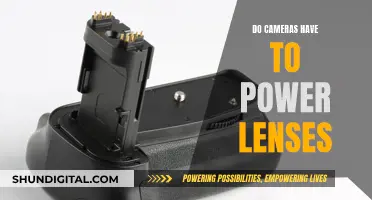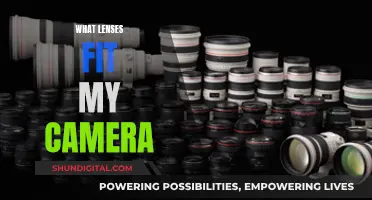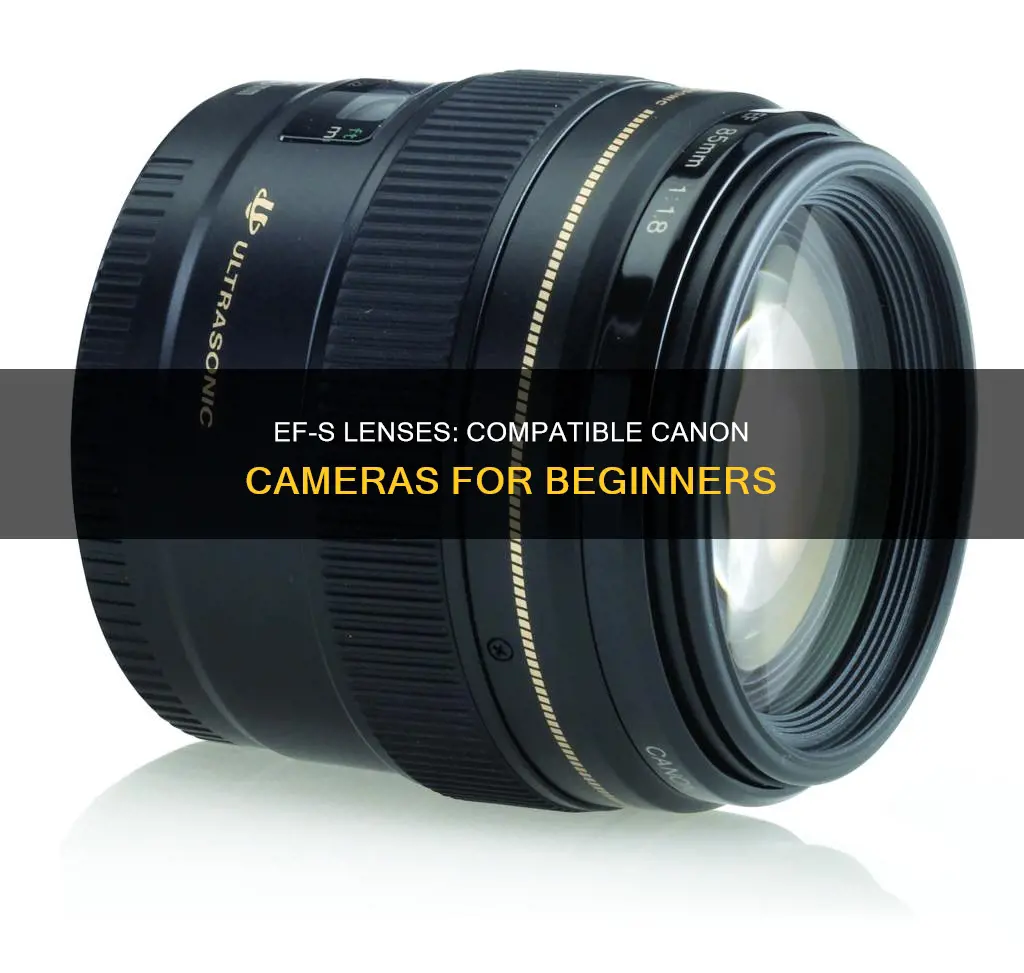
Canon EF-S lenses are compatible with Canon EOS cameras that contain both a red dot and a white square on the lens mount. The red dot means the camera supports EF-S lenses, and the white square means it also supports a standard EF lens. The EF-S lens was first developed in 2003, when Canon released its EOS 300D/Digital Rebel/Kiss range of digital SLR cameras. EF-S lenses are cheaper than EF lenses, as they are made with cheaper materials, such as plastic components instead of metal. They are aimed at hobbyists, while EF lenses are generally aimed at professionals.
What You'll Learn
- Canon EF-S lenses are compatible with Canon EOS cameras that contain a red dot and a white square on the lens mount
- Canon EF lenses are compatible with all Canon EOS camera bodies
- Canon EF-S lenses are aimed at hobbyists, while Canon EF lenses are aimed at professionals
- Canon EF-S lenses are cheaper than Canon EF lenses
- Canon EF lenses are designed to work with both full-frame and APS-C DSLR bodies, while Canon EF-S lenses are designed to work only with APS-C bodies

Canon EF-S lenses are compatible with Canon EOS cameras that contain a red dot and a white square on the lens mount
It's important to note that EF-S lenses are only compatible with specific Canon EOS camera models, typically those in the mid-range category, such as the EOS 20D and Digital Rebel bodies. These cameras feature APS-C-sized image sensors, which are smaller than the sensors in full-frame DSLR cameras. The combination of the smaller sensor and shorter back focal length distance in EF-S lenses enhances the possibilities for wide-angle and very wide-angle lenses.
EF-S lenses were introduced by Canon in 2003 alongside the EOS 300D/Digital Rebel range of digital SLR cameras. They were designed to provide a more cost-effective option for mid-range SLR camera users, particularly for wide-angle zoom lenses. While there may be no noticeable difference in the final photograph when using an EF-S lens, the main disadvantage is their limited compatibility with only certain Canon EOS camera bodies.
If you're considering purchasing an EF-S lens, it's important to check the lens mount on your Canon EOS camera to ensure compatibility. Look for the red dot and white square on the lens mount to confirm that your camera can support EF-S lenses. Additionally, keep in mind that EF-S lenses are not compatible with full-frame DSLR cameras or cameras with sensors larger than APS-C.
In summary, Canon EF-S lenses are designed to work with specific Canon EOS camera models that feature a red dot and a white square on the lens mount, indicating compatibility with both EF-S and standard EF lenses, respectively. These lenses offer a cost-effective option for photographers, especially those interested in wide-angle photography, but their compatibility is limited to select Canon EOS camera bodies with APS-C-sized image sensors.
The Magic of Camera Lenses: How They Attach
You may want to see also

Canon EF lenses are compatible with all Canon EOS camera bodies
The Canon EF-S lens mount, on the other hand, is a derivative of the EF lens mount and was created for some Canon digital single-lens reflex cameras with APS-C-sized image sensors. Cameras with the EF-S mount are backward compatible with EF lenses. However, EF-S lenses are only compatible with Canon EOS cameras that contain both a red dot and a white square on the lens mount.
The "S" in EF-S stands for either "Small image circle" or "Short back focus". The small image circle refers to the lens projecting a smaller image circle than normal EF lenses to match the sensor. "Short back focus" refers to the smaller mirror used in APS-C cameras, which allows optical elements to protrude further into the camera body, reducing the minimum distance between the sensor and the back element of the lens.
While EF-S lenses are limited to Canon EOS cameras with APS-C-sized sensors released after 2003, EF lenses are compatible with both full-frame and APS-C DSLR bodies. This makes EF lenses a more versatile option for photographers who may want to upgrade their camera body in the future.
In summary, Canon EF lenses are compatible with all Canon EOS camera bodies, offering a wide range of options for photographers using the EOS system.
Traveling with Camera Lenses: A Comprehensive Guide for Photographers
You may want to see also

Canon EF-S lenses are aimed at hobbyists, while Canon EF lenses are aimed at professionals
The EF-S lens mount was introduced in 2003, the same year that the first APS-C body, the Canon EOS 300D, was released. The primary reason for introducing the APS-C lineup was to make DSLR technology more accessible to the masses by making it cheaper, and the EF-S lenses were designed with this same goal in mind. EF-S lenses are made with cheaper materials, such as plastic instead of metal, and lower-quality glass, resulting in a lower price point. They are also lighter, containing less glass, and can be made smaller.
EF-S lenses are primarily aimed at hobbyists, while EF lenses are generally aimed at professionals. The L series of EF lenses, indicated by a red ring, are premium-quality lenses aimed exclusively at professionals, whereas EF-S lenses do not have a professional lineup. EF lenses are compatible with all Canon EOS camera bodies, while EF-S lenses are only compatible with mid-range cameras that support them (EOS 20D and Digital Rebel bodies).
While it is physically possible to use EF and EF-S lenses interchangeably, the results will differ. EF lenses can be used on both full-frame and APS-C bodies with similar results, while EF-S lenses will cause heavy vignetting when used on full-frame bodies due to their smaller image circle. On crop sensor bodies, EF and EF-S lenses can be used interchangeably and will produce images with the same field of view, but the image quality will depend on the glass itself.
The Huawei P30's Camera: A Triple-Lens Treat
You may want to see also

Canon EF-S lenses are cheaper than Canon EF lenses
Canon EF-S lenses are designed for APS-C cameras, which are typically aimed at beginners and mid-range photographers. EF-S lenses are built to be more economical than EF lenses, so they are lighter, smaller, and more affordable. The "S" in Canon EF-S lenses stands for "Small image circle" or "Short back focus". The smaller image circle means that the lens projects a smaller image to match the smaller APS-C sensor. The shorter back focus means that the lens elements can protrude further into the camera body, allowing for a more compact lens design. These design choices make EF-S lenses ideal for wide-angle lenses, as they enhance the possibilities for wide-angle and very wide-angle lenses.
Canon EF lenses, on the other hand, are designed for full-frame cameras and have a larger image circle to cover the larger sensor. EF lenses have been around since the launch of the EOS system in 1987 and are compatible with both full-frame and APS-C cameras. While EF lenses can be used on APS-C cameras, there is a crop factor of approximately 1.6x, which changes the effective focal length of the lens. For example, a 50mm lens will behave like a 80mm lens on an APS-C camera.
Due to their smaller size and more economical design, EF-S lenses are generally cheaper than EF lenses. EF-S lenses are a great option for photographers who are just starting out or have a limited budget. They offer good performance and are widely available, making them a popular choice for crop-sensor camera owners. However, if you are planning to upgrade to a full-frame camera in the future, investing in EF lenses might be a better long-term decision, as they can be used on both full-frame and crop-sensor cameras.
In addition to the cost savings, EF-S lenses also have some advantages over EF lenses when used on APS-C cameras. Since they are designed specifically for the smaller sensor, EF-S lenses can be more compact and lightweight, making them easier to carry around and balance on smaller camera bodies. The shorter back focus also allows for wider-angle lenses that are not possible with EF lenses on APS-C cameras.
In summary, Canon EF-S lenses are cheaper than Canon EF lenses because they are designed for APS-C crop-sensor cameras and feature a smaller image circle and shorter back focus. This allows for more economical construction, resulting in lighter, smaller, and more affordable lenses. While EF-S lenses are ideal for beginners and budget-conscious photographers, EF lenses offer more flexibility if you plan to upgrade to a full-frame camera in the future.
Bigger Camera Lenses: Do They Make a Difference?
You may want to see also

Canon EF lenses are designed to work with both full-frame and APS-C DSLR bodies, while Canon EF-S lenses are designed to work only with APS-C bodies
Canon EF lenses are designed to be compatible with a wide range of Canon camera bodies, including both full-frame and APS-C DSLR cameras. This versatility is due to the design of the EF lens mount, which was introduced with the launch of the EOS system in 1987.
The EF lens mount served as the foundation for the largest native lens system for interchangeable lens cameras, ensuring compatibility across Canon EOS camera bodies. As a result, Canon EF lenses can be used with various Canon DSLR models, providing flexibility and convenience for photographers.
On the other hand, Canon EF-S lenses are specifically designed for APS-C DSLR bodies. The "S" in EF-S stands for "Short Back Focus", indicating that these lenses are designed to protrude further into the camera body, reducing the distance between the lens and the sensor. This design feature allows EF-S lenses to take advantage of the smaller sensor size in APS-C cameras, enhancing the possibilities for wide-angle and very wide-angle lenses.
EF-S lenses were introduced in 2003 alongside the Canon EOS 300D, marking Canon's effort to make DSLR technology more accessible and affordable for a broader range of users. These lenses are typically made with less expensive materials, such as plastic components, and are targeted towards hobbyists or those seeking a cost-effective option.
While EF-S lenses cannot be mounted on DSLRs with sensors larger than APS-C, they can be used on APS-C bodies with similar results to EF lenses. However, when used on full-frame bodies, EF-S lenses may cause heavy vignetting due to their smaller image circle.
In summary, Canon EF lenses offer compatibility with both full-frame and APS-C DSLR bodies, providing a versatile option for photographers. On the other hand, Canon EF-S lenses are exclusively designed for APS-C bodies, offering a more affordable and specialised choice for those utilising Canon's APS-C DSLR cameras.
The Truth About Camera Lenses: Glass or Plastic?
You may want to see also
Frequently asked questions
EF-S lenses are a type of lens made by Canon for their APS-C DSLR cameras. They were first introduced in 2003 alongside the EOS 300D/Digital Rebel/Kiss range of cameras. EF-S lenses are designed to sit deeper into the camera body, which means there is less space between the lens and the sensor.
EF-S lenses are compatible with Canon EOS cameras that contain both a red dot and a white square on the lens mount. The red dot means the camera supports EF-S lenses, and the white square means it also supports a standard EF lens.
It is not recommended to use an EF-S lens on a full-frame camera. While it may be physically possible to mount the lens on the camera body, you will experience heavy vignetting due to the smaller image circle of the EF-S lens.
There are many EF-S lenses available on the market, offering a range of focal lengths and apertures to suit different photography needs. Some popular options include the Canon 10-18mm f/4.5-5.6 IS STM, Canon 50mm f/1.8 STM, and Sigma 17-50mm f/2.8.



